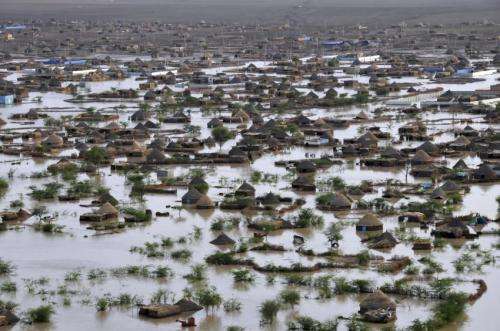June 12, 2014 report
Researchers predict global warming will cause an increase in frequency of Indian Ocean Dipole events

(Phys.org) —A team of researchers, led by Wenju Cai of CSIRO Marine and Atmospheric Research, in Australia has published a paper in the journal Nature in which they report that 21 out of 23 climate models they ran indicated an increased frequency of Indian Ocean Dipole events over the next century. The increase, the team also reports, will be due to the continuation of global warming.
Indian Ocean Dipole events are atmospheric phenomena that occur due to ocean temperature differences. They are characterized by peak sea surface temperature swings between the eastern and western basins. Positive phases of the cycle occur when warmer waters in the west lead to more rainfall there and cooler waters in the east lead to less rainfall. When this happens, land areas in the east such as Australia and Indonesia tend to undergo draughts, while those in the west such as parts of Africa undergo flooding. One example occurred in 1997 when smoke from fires in Indonesia blackened the skies across the region even as thousands of people were killed due to flooding in several African nations. In their paper, the authors of this new study suggest such occurrences are likely to happen much more often over the next several decades.
To come to their conclusions, the team examined 31 global climate models and determined that 23 of them were capable of modeling rainfall in the Indian Ocean during both normal times and when there is a dipole event occurring. They ran the models first for the period 1900, to 1999 to see how well they could predict dipole events that actually occurred, then, encouraged by the results, ran the models again, this time for the period 2000 to 2099, under what they describe as business as usual conditions. They report that 21 of 23 models predicted an increase in the frequency of positive phase Indian Ocean Dipole events—the combined average predictions suggest the region will see approximately triple the number of such events over the coming century—from one every 17.3 years to one every 6.3 years. The business as usual conditions assume greenhouse gas emissions will continue to increase at their current pace.
If such predictions come to pass it could mean an increase in fires in eastern countries, but more devastating perhaps, an increase in flooding in some of the poorest parts of the world, which would likely be made even worse in coastal areas as sea levels are predicted to rise during the same time period.
More information: Increased frequency of extreme Indian Ocean Dipole events due to greenhouse warming, Nature 510, 254–258 (12 June 2014) DOI: 10.1038/nature13327
Abstract
The Indian Ocean dipole is a prominent mode of coupled ocean–atmosphere variability, affecting the lives of millions of people in Indian Ocean rim countries. In its positive phase, sea surface temperatures are lower than normal off the Sumatra–Java coast, but higher in the western tropical Indian Ocean. During the extreme positive-IOD (pIOD) events of 1961, 1994 and 1997, the eastern cooling strengthened and extended westward along the equatorial Indian Ocean through strong reversal of both the mean westerly winds and the associated eastward-flowing upper ocean currents1, 2. This created anomalously dry conditions from the eastern to the central Indian Ocean along the Equator and atmospheric convergence farther west, leading to catastrophic floods in eastern tropical African countries13, 14 but devastating droughts in eastern Indian Ocean rim countries. Despite these serious consequences, the response of pIOD events to greenhouse warming is unknown. Here, using an ensemble of climate models forced by a scenario of high greenhouse gas emissions (Representative Concentration Pathway 8.5), we project that the frequency of extreme pIOD events will increase by almost a factor of three, from one event every 17.3 years over the twentieth century to one event every 6.3 years over the twenty-first century. We find that a mean state change—with weakening of both equatorial westerly winds and eastward oceanic currents in association with a faster warming in the western than the eastern equatorial Indian Ocean—facilitates more frequent occurrences of wind and oceanic current reversal. This leads to more frequent extreme pIOD events, suggesting an increasing frequency of extreme climate and weather events in regions affected by the pIOD.
Journal information: Nature
© 2014 Phys.org





















